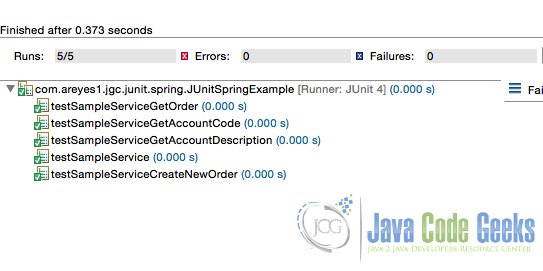Spring JUnit Test Example
In this example, I’ll be showcasing how to do Unit Tests for Spring beans using only annotations.
1. Introduction
Spring has its own testing framework for all objects created under its IOC container (that we all know is just the JVM instance). Spring has created its own paradigm of object creation and destruction and it made sense for it to have its own testing framework. The great thing about this is (as being Java) is it can be coupled with the core JUnit Testing framework, making it really easy to create JUnit Tests for its sources.
2. Maven POM
We need to include the following dependencies on our project. This will allow us to use Spring Test framework as well as the context package to allow us to inject our objects into our test cases.
pom.xml
<project xmlns="http://maven.apache.org/POM/4.0.0" xmlns:xsi="http://www.w3.org/2001/XMLSchema-instance" xsi:schemaLocation="http://maven.apache.org/POM/4.0.0 http://maven.apache.org/xsd/maven-4.0.0.xsd"> <modelVersion>4.0.0</modelVersion> <groupId>com.jgc.areyes.junit</groupId> <artifactId>junit-spring-example</artifactId> <version>0.0.1-SNAPSHOT</version> <dependencies> <dependency> <groupId>junit</groupId> <artifactId>junit</artifactId> <version>4.12</version> <scope>test</scope> </dependency> <dependency> <groupId>org.springframework</groupId> <artifactId>spring-test</artifactId> <version>4.1.7.RELEASE</version> </dependency> <dependency> <groupId>org.springframework</groupId> <artifactId>spring-context</artifactId> <version>4.1.7.RELEASE</version> </dependency> </dependencies> </project>
3. The main class file
The following source is the main junit test case code of our example. As it can be seen here, we used annotation based context configuration. This approach allow developers to wire up their beans via Java classes instead of XML files.
JUnitSpringExample.java
package com.areyes1.jgc.junit.spring;
import org.junit.After;
import org.junit.AfterClass;
import org.junit.Before;
import org.junit.BeforeClass;
import org.junit.Test;
import org.junit.runner.RunWith;
import static org.junit.Assert.*;
import static org.hamcrest.CoreMatchers.*;
import static org.hamcrest.BaseMatcher.*;
import org.springframework.beans.factory.annotation.Autowired;
import org.springframework.test.context.ContextConfiguration;
import org.springframework.test.context.junit4.SpringJUnit4ClassRunner;
import org.springframework.test.context.support.AnnotationConfigContextLoader;
import com.areyes1.jgc.junit.spring.main.AppConfig;
import com.areyes1.jgc.junit.spring.service.SampleService;
import com.areyes1.jgc.unit.obj.Order;
@RunWith(SpringJUnit4ClassRunner.class)
@ContextConfiguration(classes = AppConfig.class, loader = AnnotationConfigContextLoader.class)
public class JUnitSpringExample {
@Autowired
private SampleService sampleService;
@Test
public void testSampleService() {
assertEquals(
"class com.areyes1.jgc.junit.spring.service.SampleServiceImpl",
this.sampleService.getClass().toString());
}
@Test
public void testSampleServiceGetAccountDescription() {
// Check if the return description has a Description: string.
assertTrue(sampleService.getOrderDescription().contains("Description:"));
}
@Test
public void testSampleServiceGetAccountCode() {
// Check if the return description has a Code: string.
assertTrue(sampleService.getOrderStringCode().contains("Code:"));
}
@Test
public void testSampleServiceCreateNewOrder() {
Order newOrder = new Order();
newOrder.setSecurityCode("XYZ");
newOrder.setDescription("Description");
if (newOrder != null) {
assertThat(sampleService.createOrder(newOrder),
instanceOf(Order.class));
assertNotNull("Security isn't null", newOrder.getSecurityCode());
assertNotNull("Description isn't not null",
newOrder.getDescription());
}
assertNotNull("New Order is not null", newOrder);
}
@Test
public void testSampleServiceGetOrder() {
Order existingOrder = sampleService.getOrder(0);
if (existingOrder != null) {
assertThat(sampleService.getOrder(0), instanceOf(Order.class));
assertNotNull("Security isn't null",
existingOrder.getSecurityCode());
assertNotNull("Description isn't null",
existingOrder.getDescription());
}
assertNotNull("Object is not null", existingOrder);
}
}
@RunWith – is an annotation to tag a class that this should Run with a specific runner class. There are a lot of alternative runners for JUnit but since we are using Spring test, we use: SpringJUnit4ClassRunner.class
@ContextConfiguration – Similar to calling the ClassPathContextConfiguration, this one is a pretty neat feature in Spring, especially in Unit test cases. It can be used to what type of ContextLoader for our class and the Java class files that we need to run on the ioc container (basically JVM) that are injectable on this class. For this case, we use AnnotationConfigContextLoader.class as our ContextLoader since we are creating a fully using annotation as our context metadata information and passed our AppConfig.class as our configuration stating point.
AppConfig.java
package com.areyes1.jgc.junit.spring.main;
import org.springframework.context.annotation.Bean;
import org.springframework.context.annotation.Configuration;
import com.areyes1.jgc.junit.spring.service.SampleService;
import com.areyes1.jgc.junit.spring.service.SampleServiceImpl;
@Configuration
public class AppConfig {
@Bean
public SampleService getSampleService() {
return new SampleServiceImpl();
}
}
After implementing these 2 annotations, passing the correct context loader and configuration classes, we can now use Spring based annotation on our JUnit Test case classes. You can see this in action by looking at the class above when we injected the SampleService via wiring (@Autowired).
We then proceed with creating our JUnit Test cases for all specific method that the SampleService has (We need to include as much Junit Test case for each method as possible as this will greatly contribute to the coverage).
4. Output
5. Download the Eclipse project
This was an example of Spring JUnit Test.
You can download the full source code of this example here: Spring JUnit Test Example
Last updated on Jun. 29th, 2021




